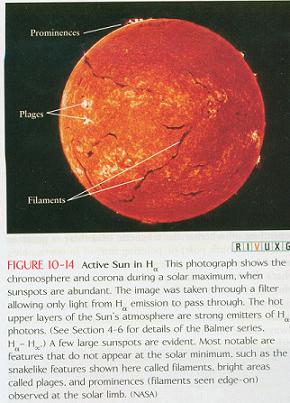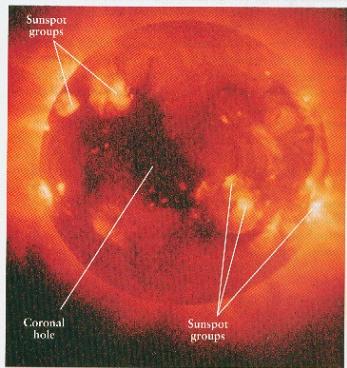CHAPTER 10 REVIEW
How many earth masses could fit into the sun?
333,000
Also, compare the percentage of the rest of the solar system mass to the mass of the sun.
The solar system is only 0.15% the mass of the sun.

Why do we call the photosphere the “visible sphere”? Where does the photosphere sit in relation to the other layers of the sun? What is the average temperature of the photosphere?
The photosphere is called the "visible sphere" because it is the first layer that has a blackbody spectrum that we can see. The outer two layers are transparent to most visible light.
The photosphere is the third layer of the sun.
The average temperature is 5800 K.
Why does the edge of the sun appear darker than the center? What is this phenomenon called?
The edge of the sun appears darker than the center because of a phenomenon called "limb darkening." This is because the sun is a sphere and when we look at the edges we are looking through thicker sections of the photosphere and it appears darker.
On the sun, what is the largest composition by mass? What is the second most prevalent by mass? How do the mass percentages compare to the percentage of the actual number of atoms? What creates the difference?
The Sun's composition by mass is 74% hydrogen and 25% helium. Its composition by atoms is 92.1% hydrogen, and 7.8% helium. The difference is created by the mass of the hydrogen atoms being less than the mass of the helium atoms.
How far is the sun from the center of the galaxy?
26,000 light years
What is the orbital period? How fast is the sun moving?
220 million years
220 km/s
How large are the individual granules on the sun? How does their color relate to their temperature? Do they ever change?
Individual granules are about 1000 km across.
The granules are brighter in the center where they are hottest due to the hot gas rising. They are darker along the edges due to the lower temp of the gas falling.
Granules only last for a few minutes before they disappear.
What is the layer of the sun called that is sandwiched between the corona and the photosphere? What is the range of temperatures here? How tall does it get?
The chromosphere
4000 K at the bottom to 10,000 K at the top.
It extends 2,000 km above the photosphere with spicules rising about 10,000 km.
Define spicules and describe where they occur.
Spicules are jets of superheated gas that rise from the chromosphere.

Between the chromosphere and the corona is the transition zone. What is it most notable for?
It is most noted for temperatures sky-rocketing to about 1 million K.
How large is the corona? How does its size relate to the disk of the sun we see?
The corona extends several million km above the chromosphere.
In some places, it extends the length of the visible disk of the sun we see.
How much matter makes up the solar wind each second? What is the composition of the solar wind? How does the density of the solar wind as it reaches earth compare to earth’s atmosphere?
The sun ejects about a million tons of matter each second as solar winds.
It is comprised of electrons, hydrogen, helium, silicon, sulfer, calcium, chromium, nickle, neon, and argon.
When it reaches earth it has a density of about 5 particles per cubic centimeter. The air we breathe has about 6x10^19 particles per cubic centimeter.
What are the regions of a sunspot? How does the temperature vary inside a sunspot and how does that relate to its color?
Umbra, and penumbra.
The umbra is the dark core with a temp of about 4300 K.
The lighter penumbra ring is about 5000 K.

What is the rate of rotation of the sun? Who discovered this and how did he discover it?
The sun rotates once every four weeks.
Galileo discovered this when he was studying sunspots.
We now know that the sun does not rotate rigidly –does the equator or the polar region rotate faster? What are the specific rates of rotation?
The equator rotates every 25 days while the poles rotate every 35 days.

What cycle do the sunspots have? Why can it be considered either an 11 year or a 22 year cycle? Where do sunspots form first? How do they move or grow across the sun’s surface? What would you give as the definition of the solar cycle?
Sunspots have an 11-year cycle. It can also be a 22-year cycle because the poles reverse themselves every 11 years.
They usually appear to form around 30 degrees north or south latitudes. They rotate with the sun moving towards the equator.
A solar cycles is a period of time between sunspot maximums.
What is the Zeeman Effect and how did George Ellery Hale use it to help describe the formation of sunspots? What phenomena below the surface of the photosphere help maintain the sunspots for longer periods of time?
The Zeeman Effect is when an intense magnetic field splits a spectral line into two or more lines. Hale used this effect to describe the formation of sunspots when he pointed a spectroscope at one and discovered split lines.
The phenomena below the photosphere that maintains sunspots is plasma in the photosphere preventing hot, ionized gases inside from reaching the surface keeping sunspots cooler. Below each sunspot, gases are whipping around like a hurricane holding the sunspot in place.
How does the magnetic field of the sun become so tangled?
It becomes entangles because the poles of the field are held still while it rotates at the equator.
In the past, did a sunspot maximum or a sunspot minimum occur with a cold spell on earth? What is the evidence presented for the Maunder minimum? Why is the sun more red-orange during a sunspot maximum and how does this possibly describe changes of temperatures as evidenced on earth?
A sunspot minimum occured during a cold spell on earth.
The evidence for the Maunder Minimum is that periods of low sunspot activity coincide with colder-than-average temperatures on earth.
The sun appears more red-orange during a maximum because the sunspots cause the sun to be dimmer.
What do scientists believe causes plages?
Plages are believed to be caused by the magnetic field under the photosphere crowding upward just before they emerge through.
Filaments and prominences are the same thing but viewed from different vantage points. Describe them and tell how they form.
Filaments are dark streaks that appear on the sun when viewed from above while prominences are the same thing, huge volumes of gas lofted upward from the photosphere, but viewed from the side.

What is the significance of a coronal hole?
Coronal holes are dark, cool spots in the corona that act as conduits for gases to flow out of the sun.
When a coronal hole faces the earth, the solar wind in our direction increases dramatically.
What causes solar flares? How have scientists used them to their advantage?
Solar flares are caused by strong, violent eruptions in the sun.
Scientists use satellites to monitor space weather and forecast several days in advance the arrival of dangerous levels of solar particles which follow solar flares. This allows time for sensitive equipment to be protected.

Compare the strength of a prominence, solar flare, and coronal mass ejection. What happens to earth if the energy from these is pointed toward us?
Prominences can reach temps of 50,000 K. Solar flares can reach 5 million K. Coronal mass ejections typically expel 2 trillion tons of matter at 400 km/s.
When energy from these is aimed at earth, most of it is deflected by the Van Allen Belt, but some particles can get through damagind satellites, disrupting radio communication, short out power grids, produce intense aurorae in the earth's atmosphere, cause some of the earth's atmosphere to gush into space, and harm or kill people in space.
Describe the changes that the hydrogen atoms go through as thermonuclear fusion takes place? What temperature does the core of the sun have for this to occur?
Two protons collide creating a neutron, proton, positron, and a neutrino. The proton and the neutron form a hydrogen isotope(2H). The positron encounters an electron and they annihilate each other producing a gamma-ray photon. The 2H nucleus then collides with another proton forming a helium isotope (3He). In the process, another gamma-ray photon is released. Then two 3He nuclei collide forming a different type of helium (4He) with two protons and two neutrons. Two protons are released. The core has to be 15.5 million K for this to happen.

How are the Conservation of Energy Law and the Conservation of Matter Law incorrect? What statement could you make to correct the error?
The laws are incorrect because matter can be converted into energy and vice versa. The correct statement would be that the total amount of mass and energy is conserved.
Define hydrostatic equilibrium and describe how this balance is maintained in the sun.
Hydrostatic equilibrium - the balance between the inward force of gravity and the outward force from the motion of hot gas
This is maintained by the frequent interaction of the tightly packed, energetic electrons in the sun's core counter-balancing gravity.
If individual photons take 170,000 years to travel from the core to the surface of the sun, how is the energy transferred faster than that?
Energy is trasferred to the surface through a process called radiative transport which is outward energy movement by photons hitting particles, which then bounce off other particles and thereby reemit photons.
To what does the radiative zone refer? How does this compare to the convective zone?
The radiative zone extends from the core to 80% of the way out to the photosphere and is the place that radiative transport is the dominant means of outward energy.
The convective zone in the last 20% where blobs of gas circulate the energy to the surface of the photosphere.
What is a neutrino? Where are neutrino detectors found? Why? How did the original neutrino detection rate compare with the predictions of created neutrinos? To what conclusion did this lead astronomers?
A neutrino is a nearly massless particle that has no charge and rarely interacts with ordinary matter.
Detectors are found underground to avoid contamination from other forms of energy.
The original detection rate only corresponded to 1/3 of the particles predicted to be produced by the sun. Astronomers concluded that 2/3 of the created neutrinos changed into other undetectable types before they reached earth.
What is Cerenkov radiation and how is it produced?
Flashes of light caused by particles of deterium moving faster than light after a neutrino has collided with it.






